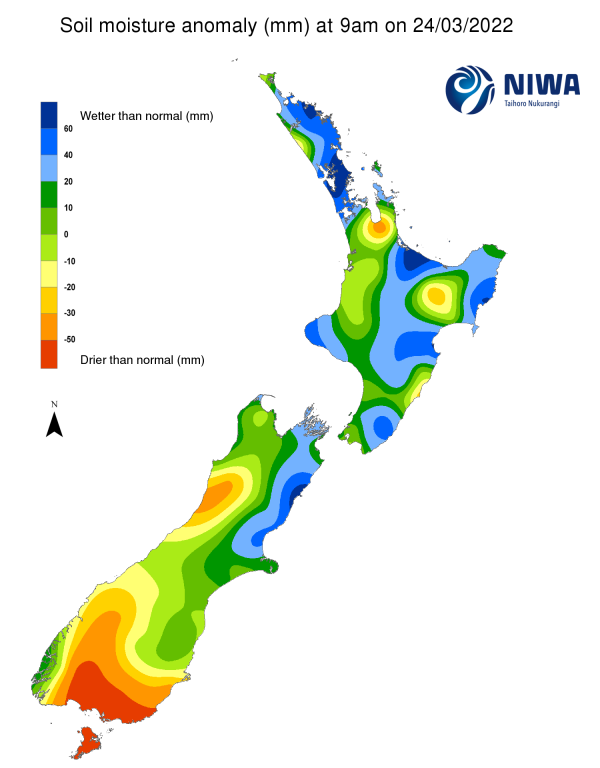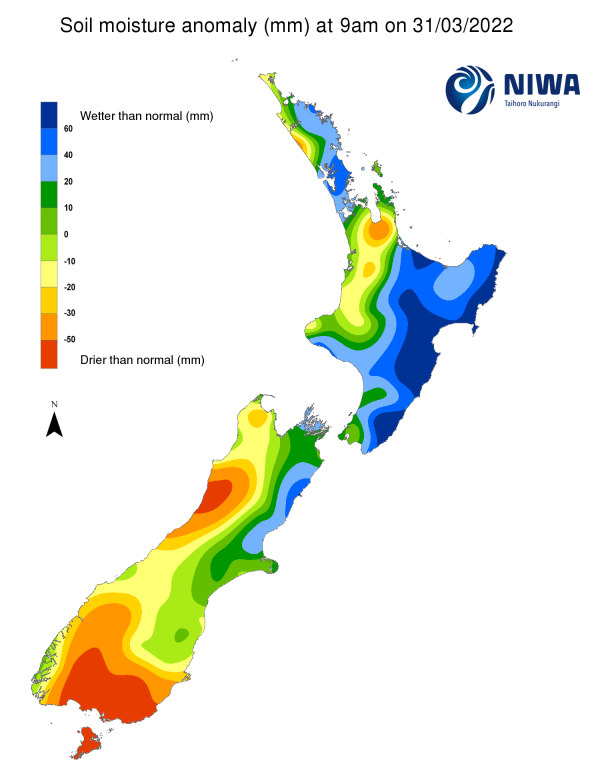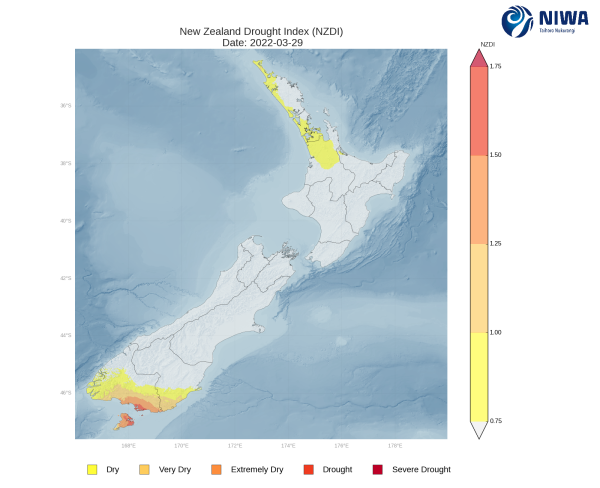A weekly update describing soil moisture patterns across the country to show where dry to extremely dry conditions are occurring or imminent. Regions experiencing significant soil moisture deficits are deemed “hotspots”. Persistent hotspot regions have the potential to develop into drought.
Facts: Soil Moisture
Rainfall was sparse across Aotearoa New Zealand over the last week, aside from the eastern and central North Island where more than 30 mm of rain was widespread. From Gisborne through Hawke’s Bay in particular, rainfall commonly exceeded 75 mm, with some areas receiving more than 150 mm. Since Friday 25 March, Invercargill recorded just 0.2 mm of rain; although some measurable rainfall is expected on Thursday night, it will become one of the driest Marches on record in the Southland town.
In the North Island, soil moisture levels were generally normal or above normal, for the time of year, with the exception of the Hauraki Plains in Waikato, the Kaipara District in Northland, and around New Plymouth in Taranaki. The driest soils across the North Island, when compared to normal for the time of the year, are found near the Firth of Thames. The wettest soils for the time of the year are found in Bay of Plenty, Gisborne, Hawke’s Bay, and Wairarapa. Small hotspots redeveloped in the Firth of Thames and in northern Kaipara over the last week.
The driest soils in the South Island, when compared to normal for the time of the year, are located in southern Southland, Stewart Island, and in the Grey District along the West Coast, while the wettest soils for the time of the year are found in northern Canterbury. Hotspots remain over the south coast of Otago, much of southern Southland, and Stewart Island. A new hotspot developed in the Queenstown-Lakes District.
As of 29 March, the New Zealand Drought Index (NZDI) indicated dry or very dry conditions in coastal Otago and much of southern Southland. Extremely dry conditions were located in coastal Southland and nearly all of Stewart Island, with meteorological drought expanding near Tiwai Point and in northern Stewart Island.
Outlook and Soil Moisture
In the North Island, low rainfall totals are expected over the next week along with a continuation of above average temperatures. Weekly rainfall will likely be less than 10 mm in most places, possibly with the exception of parts of Taranaki and South Waikato.
Soil moisture levels may remain the same or decrease slightly in most places, with hotspots in the Hauraki Plains and Kaipara continuing. The development of new hotspots is unlikely.
In the South Island, a few fronts may bring modest rainfall to the driest areas in the south and west, with about a 50% chance for more than 10 mm in Southland and Stewart Island. Weekly totals of 25-50 mm look likely along the West Coast. Amounts of 10 mm or less are likely in the east and north.
Soil moisture levels may remain the same or increase slightly in the driest areas. Even if a small improvement were to occur, it will take several soaking rainfall events to ease the dryness, particularly in Southland. Hotspots in Otago, Southland, and Stewart Island, while unlikely to ease, might not grow or intensify over the week ahead.
NIWA’s climate outlook for April-June has about equal odds for below normal or near normal rainfall in the western and lower South Island.
Background:
Hotspot Watch: a weekly advisory service for New Zealand media. It provides soil moisture and precipitation measurements around the country to help assess whether extremely dry conditions are imminent.
Soil moisture deficit: the amount of water needed to bring the soil moisture content back to field capacity, which is the maximum amount of water the soil can hold.
Soil moisture anomaly: the difference between the historical normal soil moisture deficit (or surplus) for a given time of year and actual soil moisture deficits.
Definitions: “Extremely” and “severely” dry soils are based on a combination of the current soil moisture status and the difference from normal soil moisture (see soil moisture maps at https://www.niwa.co.nz/climate/nz-drought-monitor/droughtindicatormaps)
Hotspot: A hotspot is declared if soils are "severely drier than normal" which occurs when Soil Moisture Deficit (SMD) is less than -110 mm AND the Soil Moisture Anomaly is less than -20 mm.
Pictured above: Soil Moisture Anomaly Maps, relative to the time of year. The maps show soil moisture anomaly for the past two weeks.
New Zealand Drought Index (NZDI)
As of 29 March, the New Zealand Drought Index (NZDI) below indicates dry conditions in Northland, Auckland, northern Waikato, coastal Otago, and much of Southland. Very to extremely dry conditions are occurring in parts of coastal Southland and Stewart Island, with meteorological drought expanding near Tiwai Point and in Stewart Island.
Please note: some hotspots in the text above may not correspond with the NZDI map. This difference exists because the NZDI uses additional dryness indices, including one which integrates the rainfall deficit over the past 60 days. Changes are therefore slower to appear in the NZDI compared to soil moisture anomaly maps that are instantaneously updated.



